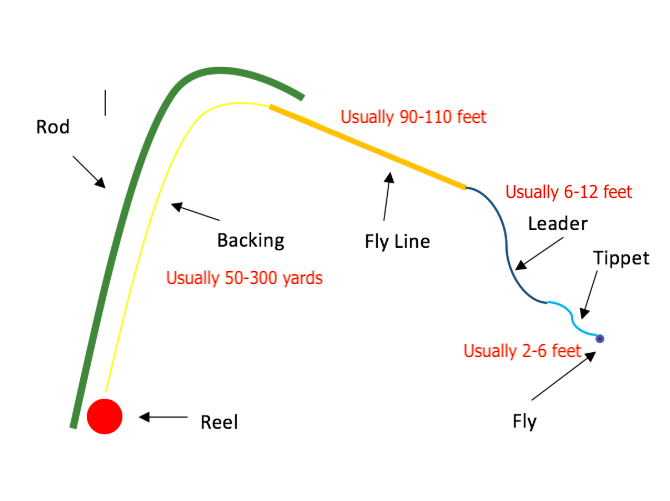Beginner fly fisherman can easily get overwhelmed with all the terms, gear, and technique with fly fishing. We can relate. In this guide, we highlight fly fishing leaders, and what beginners should know.
Before diving into this article, we have a few resources that you should also check out as a beginner fly angler:
Complete Beginner’s Guide To Fly Fishing
The Importance of Fly Fishing Leaders
To some who haven’t gone fly fishing yet, fishing might seem like a piece of cake. Throw on a fly, wait for the fish to take it, reel it in, end of story. It takes one closer look to see other stages of that process and how complex it can be. Take a new fly angler on the water, and people get humbled quickly.
Leaders are an essential part of the fly fishing setup, as the leader is what allows the angler to delicately present flies to fish accurately, is key in actually holding the fish on the line. Without a leader, a fly angler won’t be able to present flies to the fish without spooking them, and likely will be unable to catch fish.
What is a Fly Fishing Leader?
First, we wanted to highlight the below diagram, as the leader is just one piece of the full fly setup. Leader is thin, strong material, tied to the fly line, that acts as the piece of line between the fly line and the tippet that connects directly to the fly. Sometimes leader and tippet are combined into one piece.

Leader Materials
Fly fishing leader is usually monofilament, that connects the main line to the fly. It transfers energy from the line to the fly, turning the latter over during casting.
In addition to monofilament, sometimes fly anglers will use fluorocarbon material (usually just a tippet material), and occasionally metal or braided line when fishing for fish with teeth.
Attaching Leader To Fly Line
Many manufacturers, like Scientific Anglers, manufacture fly lines with welded loops, making tying on the leader to the fly line substantially more simple than without welded loops. That being said, some fly lines don’t have this loop.
It is much easier to watch a video on this topic. Here is one of the best videos on the topic.
Tapered Leaders vs. Parallel Leaders
There are two main types or styles of fly leaders- tapered and parallel. Tapered leaders are the most common, and their design features a thicker base (butt section) that gradually tapers down to a thinner end. Tapered leaders turn over more efficiently when cast due to this tapered design.
Tapered leaders are almost always preferred to parallel leaders due to better casting, less drag in the water, and ease of use.
Parallel leaders have the same diameter along the entire length of the leader. They are cheap and easy to replace. Unlike tapered leaders, they don’t require tippets and you can safely cut them without fearing to hinder their performance.
When to Use Tapered vs. Parallel Leaders
Tapered leaders are ideal for flies that can’t boast superior aerodynamics. If you use a light fly and want to achieve a delicate presentation, then a tapered leader will be a good choice. It allows for a smoother transfer of energy, resulting in a more natural cast. Tapered leaders also help eliminate water disturbance, making them ideal for fishing in slow-moving and clear water, or even fast moving water with currents that can affect a fly’s drift.
Parallel leaders are perfect if you use a heavier fly, like with nymph or lure fishing. They are often used for casting on large still waters. They are also great to create on your own when you are in a pinch, or are running out of tapered leaders.L
Building Your Own Leaders
The truth is, a leader is just a long piece of material, and it is easy to build your own leader. This is another topic that is simply easier to show than it is to explain:
Leader Class: Breaking Strain
Like all other lines, leaders are prone to breaking, which makes breaking strain (class) another important feature to consider. The breaking strain refers to the amount of weight that the leader can sustain before it breaks. It is essential to choose a breaking strain that is suitable for the fish species you plan to catch. For example, if you are targeting a species of fish that is known to be strong and aggressive, like a salmon, you would want to consider a stronger breaking strain leader. In contrast, if you are fishing for a smaller and less aggressive fish type, like a panfish, a lighter breaking strain would suffice.
Leaders can be extremely lightweight, up to hundreds of pounds for saltwater fish.
Tapered Leaders and Tippets
As you already know, tapered leaders get thinner towards the end. When you cut off your fly and tie a new one, you inevitably lose an inch or two or three of the leader. After a few tries, the point where your tapered leader ends will become thicker as all the thin part is cut away. This inevitably affects the performance, as being narrower towards the end is the distinctive feature of tapered leaders. Once this happens, anglers start attaching tippet to mimic the taper, and get the required length of the overall leader and tippet setup.
Conclusion
The importance of selecting the right fly leader cannot be overstated. As an essential part of any fly fishing setup, the leader’s design and length play a crucial role in the presentation of your fly, and ultimately, your chances of catching fish. Take time to consider the type of fishing you plan to do and the factors at play before selecting a fly leader. Lastly, ensure that you opt for quality fly leader products that can deliver consistent and reliable performance.
This article was written by a non hikingandfishing.com team member, but was reviewed and edited by our staff for accuracy.

Timothy Chandler is a seasoned outdoors enthusiast and content writer who specializes in fishing among other outdoor activities. Since the first memorable fishing trip with his dad, Timothy has been hooked on angling. He loves sharing his experiences and insights and inspiring others to spend more time outdoors.
